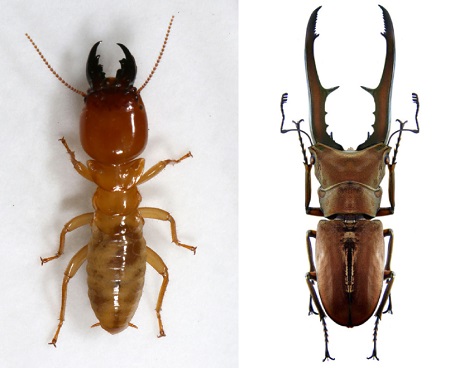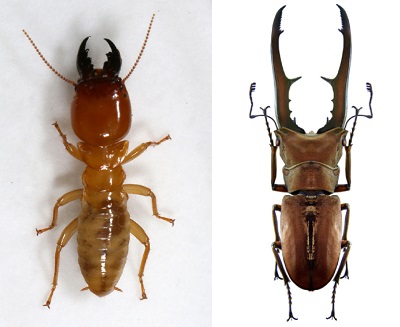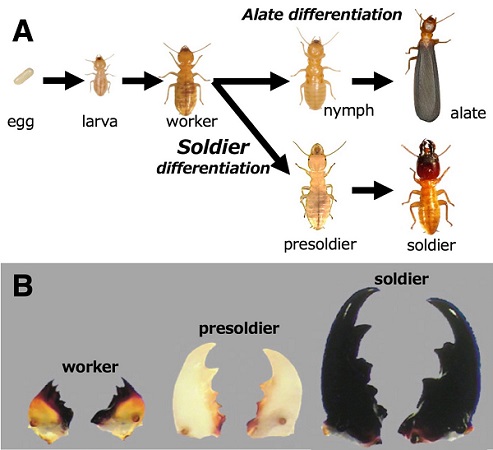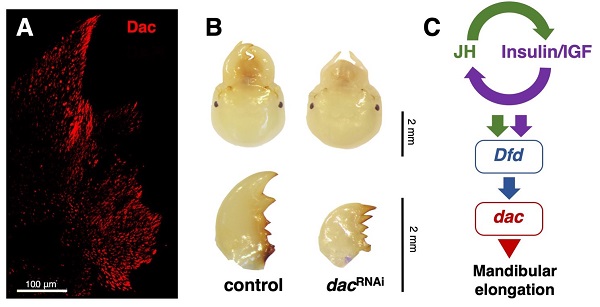How the termite got its giant jaw: Genetic study finds similar genetic method to stag beetles


A research team led by Professor Toru Miura has discovered that the gene dachshund is required to elongate the apical portion of the insects' jaws. (Photos not to scale.)
Soldier termite photo © Termite Research Team, Czech University of Life Sciences Prague. Stag beetle by Udo Schmidt, CC-BY-SA.
Termites develop their oversized jaws due to a combination of hormone and genetic signals. Researchers say that studies like this recent one in termites help advance understanding of common biological methods to control organ size in other animals.
Termites, whether they live as pests in wooden homes or in giant mounds in the desert, are social insects. A single termite community contains individuals specialized for specific jobs in what researchers call a caste system: a queen for reproduction, workers for food foraging, and soldiers for defense. Soldier termites are not born with their giant, biting jaws, but develop them as juveniles.
“Since I was a graduate student, I have been fascinated by caste differentiation in termites. There are lots of enigmas in the detailed developmental mechanisms of how termites specialize into their different roles after they are born,” said Professor Toru Miura from the Misaki Marine Biological Station.
Scientists have known that spending time around other members of the community activates certain hormones in soldier termites and that those hormones are necessary for growth of their giant jaws. However, hormones circulate throughout the entire body, and the only part of soldier termites that becomes supersized is their jaws.
“Therefore, soldier termites should require some gene functions that provide spatial information for body part-specific growth,” said Miura.
Researchers began their experiments by analyzing the expression of 18 candidate genes known to be involved in the development of insect appendages. They identified one gene, dachshund (dac), that was expressed only in soldier termites and only in their jaws. Interfering with normal dac expression caused termites to have shortened jaws, indicating that dac is required for jaw elongation.
Additional experiments to quantify the activity of hormones and the activity of the genes that determine general body pattern in all animals (Hox genes) revealed that the expression of dac was regulated downstream of those other factors, indicating its specificity for soldier termite jaw elongation.
In a previous study published in 2017 while Miura was affiliated with Hokkaido University, his research team also identified the same dac gene is required for the elongation of the giant jaws of stag beetles (Gotoh et al., 2017 DOI: 10.1016/j.ydbio.2016.12.011).
“An important question in developmental biology is how organ proportion is regulated by the interplay of genetic and environmental stimuli. In this respect, our study provides insights into the development and evolution of animal body plans,” said Miura.
Collaborators at Hokkaido University, Nagoya University, Keio University, University of the Ryukyus, and the National Institute for Basic Biology also contributed to this research.

(A) Caste differentiation pathways in the termite species Hodotermopsis sjostedti. Soldiers differentiate from workers through a presoldier stage. (B) Mandibles (jawbones) are enlarged during the soldier differentiation. Particularly, the apical (top, tip) portions are more elongated.
© 2019 Toru Miura, originally published in Development, DOI: 10.1242/dev.171942.

(A) Dac protein localizes especially at apical part of soldier mandibles. (B) The mandibular elongation was inhibited by RNAi for dac gene. (C) The relationship among factors that control the mandibular elongation. Dac expression was regulated downstream of the juvenile hormone and insulin and a Hox gene, Deformed (Dfd).
© 2019 Toru Miura, originally published in Development, DOI: 10.1242/dev.171942.
Papers
Sugime Y, Oguchi K, Gotoh H, Hayashi Y, Matsunami M, Shigenobu S, Koshikawa S, Miura T, "Termite soldier mandibles are elongated by dachshund under hormonal and Hox-Gene controls.," Development: March 4, 2019, doi:10.1242/dev.171942.
Link (Publication )
)
Related links
- Miura Lab, Misaki Marine Biological Station, Graduate School of Science

- Misaki Marine Biological Station

- Graduate School of Science





